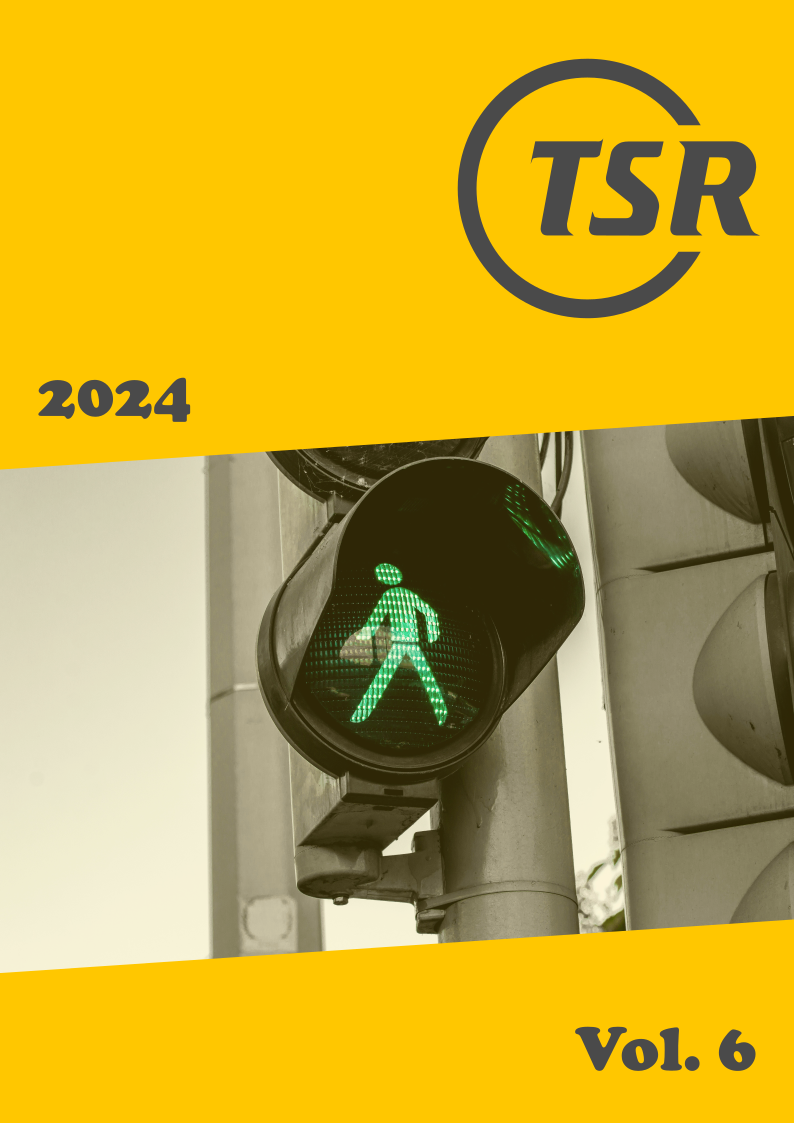The effectiveness and efficacy of driving interventions with ADHD: a Dutch perspective
DOI:
https://doi.org/10.55329/llbl9209Keywords:
attention deficit hyperactivity disorder (ADHD), crashes, driving, graduated driver licensing (GDL), medication, restrictions, technology, trainingAbstract
The diagnosis of attention deficit hyperactivity disorder (ADHD) has been identified as a factor associated with an increased risk of involvement in car crashes. As a result, individuals in the Netherlands who are diagnosed with ADHD are mandated to undergo a psychiatric evaluation before obtaining their driving licence, optionally complemented with a driving test. Recent research has, however, demonstrated that 96% of individuals pass this procedure and can drive unrestrictedly, suggesting that current regulations have a limited impact and that a different regulatory approach may be warranted. This paper addresses three such potential interventions, exploring the scientific basis of implementing mandatory behavioural training programmes, the mandatory installation of driver monitoring systems, and temporary driving restrictions. To initiate this exploration, an analysis is made of the body of literature pointing towards a subpar driving performance in those with ADHD, accompanied by a discussion of the underlying symptoms and behaviours contributing to these findings. Furthermore, between- and within-individual factors affecting ADHD driving performance are reviewed. This examination illuminates a consistent pattern of substandard driving performances among those with ADHD, whereby the period shortly post-licensure stands out as a focal point for regulatory approaches. Following these results, the three potential driving interventions are reviewed to discern their impact on road safety when implemented specifically for drivers with ADHD. Corresponding studies suggest that all these interventions hold promise in improving driving performances, but the analysis is limited by the scarcity of long-term, ADHD-specific research. The paper concludes by discussing the feasibility of these ADHD-specific driving interventions, weighing their potential benefits, e.g., reduced crash rates, along with their associated costs, such as potential stigma and hindrance in societal integration and participation. Additionally, avenues for future research in these domains are outlined.
Downloads
References
Adler, L. D., A. A. Nierenberg (2010), 'Review of medication adherence in children and adults with ADHD', Postgraduate Medicine, 122(1), 184–191. DOI: https://doi.org/10.3810/pgm.2010.01.2112
Aduen, P. A., D. J. Cox, G. A. Fabiano, A. A. Garner, M. J. Kofler (2019), 'Expert recommendations for improving driving safety for teens and adult drivers with ADHD', The ADHD Report, 27(4), 8–14. DOI: https://doi.org/10.1521/adhd.2019.27.4.8
Aduen, P. A., M. J. Kofler, D. E. Sarver, E. L. Wells, E. F. Soto, D. J. Cox (2018), 'ADHD, depression, and motor vehicle crashes: A prospective cohort study of continuously-monitored, real-world driving', Journal of Psychiatric Research, 101, 42–49. DOI: https://doi.org/10.1016/j.jpsychires.2018.02.026
American Psychiatric Association, (2013), Diagnostic And Statistical Manual Of Mental Disorders, Fifth Edition, (Washington, US: American Psychiatric Association). DOI: https://doi.org/10.1176/appi.books.9780890425596
Arnett, J. J. (2002), 'Developmental sources of crash risk in young drivers', Injury Prevention, 8(2), 17–20. DOI: https://doi.org/10.1136/ip.8.suppl_2.ii17
Austroads & National Transport Commission, (2022), 'Assessing fitness to drive for commercial and private vehicle drivers', Austroads & National Transport Commission, Medical standards for licensing and clinical management guidelines.
Baggetta, P., P. A. Alexander (2016), 'Conceptualization and operationalization of executive function', Mind, Brain, and Education, 10(1), 10–33. DOI: https://doi.org/10.1111/mbe.12100
Barkley, R. A., D. J. Cox (2007), 'A review of driving risks and impairments associated with attention-deficit/hyperactivity disorder and the effects of stimulant medication on driving performance', Journal of Safety Research, 38(1), 113–128. DOI: https://doi.org/10.1016/j.jsr.2006.09.004
Barkley, R. A., K. R. Murphy, G. J. Dupaul, T. Bush (2002), 'Driving in young adults with attention deficit hyperactivity disorder: Knowledge, performance, adverse outcomes, and the role of executive functioning', Journal of the International Neuropsychological Society, 8(5), 655–672. DOI: https://doi.org/10.1017/S1355617702801345
Barkley, R. A., K. R. Murphy, M. Fischer (2010), ADHD in adults: What the science says, (New York, US: The Guilford Press).
Barkley, R. A., K. R. Murphy, D. Kwasnik (1996), 'Motor vehicle driving competencies and risks in teens and young adults with attention deficit hyperactivity disorder', Pediatrics, 98(6), 1089–1095. DOI: https://doi.org/10.1542/peds.98.6.1089
Barkley, R., D. C. Guevremont, A. D. Anastopoulos, G. J. DuPaul, T. L. Shelton (1993), 'Driving-related risks and outcomes of attention deficit hyperactivity disorder in adolescents and young adults: a 3- to 5-year follow-up survey', Pediatrics, 92(2), 212–218. DOI: https://doi.org/10.1542/peds.92.2.212
Begg, D. J., S. Stephenson, J. Alsop, J. D. Langley (2001), 'Impact of graduated driver licensing restrictions on crashes involving young drivers in New Zealand', Injury Prevention, 7(4), 292–296. DOI: https://doi.org/10.1136/ip.7.4.292
Biederman, J., R. Fried, M. C. Monuteaux, B. Reimer, J. F. Coughlin, C. Surman, M. Aleardi, M. Dougherty, S. Schoenfeld, T. Spencer, S. V. Faraone (2007), 'A laboratory driving simulation for assessment of driving behavior in adults with ADHD: A controlled study', Annals of General Psychiatry, 6, 4. DOI: https://doi.org/10.1186/1744-859X-6-4
Bishop, H., L. Boe, D. Stavrinos, J. Mirman (2018), 'Driving among adolescents with autism spectrum disorder and attention-deficit hyperactivity disorder', Safety, 4(3), 40. DOI: https://doi.org/10.3390/safety4030040
Bolderdijk, J., J. Knockaert, E. Steg, E. Verhoef (2011), 'Effects of Pay-As-You-Drive vehicle insurance on young drivers’ speed choice: Results of a Dutch field experiment', Accident Analysis & Prevention, 43(3), 1181–1186. DOI: https://doi.org/10.1016/j.aap.2010.12.032
Botzer, A., O. Musicant, A. Perry (2017), 'Driver behavior with a smartphone collision warning application—A field study', Safety Science, 91, 361–372. DOI: https://doi.org/10.1016/j.ssci.2016.09.003
Bron, T. I., D. Bijlenga, M. Breuk, M. Michielsen, A. Beekman, J. J. S. Kooij (2018), 'Risk factors for adverse driving outcomes in Dutch adults with ADHD and controls', Accident Analysis & Prevention, 111, 338–344. DOI: https://doi.org/10.1016/j.aap.2017.12.011
Brown, T. E. (2009), 'ADD/ADHD and impaired executive function in clinical practice', Current Attention Disorders Reports, 1(1), 37–41. DOI: https://doi.org/10.1007/s12618-009-0006-3
Bruce, C., C. Unsworth, R. Tay (2014), 'A systematic review of the effectiveness of behavioural interventions for improving driving outcomes in novice drivers with attention deficit hyperactivity disorder (ADHD)', British Journal of Occupational Therapy, 77(7), 348–357. DOI: https://doi.org/10.4276/030802214X14044755581745
Carsten, O. M. J., F. N. Tate (2005), 'Intelligent speed adaptation: Accident savings and cost-benefit analysis', Accident Analysis & Prevention, 37(3), 407–416. DOI: https://doi.org/10.1016/j.aap.2004.02.007
CBR, (2024), 'Kan ik autorijden met ADHD of ADD? [Can I drive with ADHD or ADD?]'.
CBR, (2024), 'Hoe bepaalt het CBR of ik veilig kan rijden? [How does the CBR determine if I can drive safely?]', CBR.
Chang, Z., P. Lichtenstein, B. M. Onofrio, A. Sjölander, H. Larsson (2014), 'Serious transport accidents in adults with attention-deficit/hyperactivity disorder and the effect of medication: A population-based study', JAMA Psychiatry, 71(3), 319–325. DOI: https://doi.org/10.1001/jamapsychiatry.2013.4174
Chang, Z., P. D. Quinn, K. Hur, R. D. Gibbons, A. Sjölander, H. Larsson, B. M. Onofrio (2017), 'Association between medication use for attention-deficit/hyperactivity disorder and risk of motor vehicle crashes', JAMA Psychiatry, 74(6), 597–603. DOI: https://doi.org/10.1001/jamapsychiatry.2017.0659
Chapman, E. A., S. V. Masten, K. K. Browning (2014), 'Crash and traffic violation rates before and after licensure for novice California drivers subject to different driver licensing requirements', Journal of Safety Research, 50, 125–138. DOI: https://doi.org/10.1016/j.jsr.2014.05.005
Charach, A., R. Fernandez (2013), 'Enhancing ADHD medication adherence: Challenges and opportunities', Current Psychiatry Reports, 15, 371. DOI: https://doi.org/10.1007/s11920-013-0371-6
Cherkasova, M. V., A. Roy, B. S. G. Molina, G. Scott, G. Weiss, R. A. Barkley, J. Biederman, M. Uchida, S. P. Hinshaw, E. B. Owens, L. Hechtman (2022), 'Review: Adult outcome as seen through controlled prospective follow-up studies of children with attention-deficit/hyperactivity disorder followed into adulthood', Journal of the American Academy of Child & Adolescent Psychiatry, 61(3), 378–391. DOI: https://doi.org/10.1016/j.jaac.2021.05.019
Cox, D. J., V. Madaan, B. S. Cox (2011), 'Adult attention-deficit/hyperactivity disorder and driving: Why and how to manage it', Current Psychiatry Reports, 13, 345–350. DOI: https://doi.org/10.1007/s11920-011-0216-0
Cox, D. J., M. Moore, R. C. Burket, R. L. Merkel, A. Y. Mikami, B. Kovatchev (2008), 'Rebound effects with long-acting amphetamine or methylphenidate stimulant medication preparations among adolescent male drivers with attention-deficit/hyperactivity disorder', Journal of Child and Adolescent Psychopharmacology, 18(1), 1–10. DOI: https://doi.org/10.1089/cap.2006.0141
Cox, D. J., M. Punja, K. Powers, R. L. Merkel, R. C. Burket, M. Moore, F. P. Thorndike, B. Kovatchev (2006), 'Manual transmission enhances attention and driving performance of ADHD adolescent males: pilot study', Journal of Attention Disorders, 10(2), 212–216. DOI: https://doi.org/10.1177/1087054706288103
Crundall, D., B. Andrews, E. van Loon, P. Chapman (2010), 'Commentary training improves responsiveness to hazards in a driving simulator', Accident Analysis & Prevention, 42(6), 2117–2124. DOI: https://doi.org/10.1016/j.aap.2010.07.001
Cunningham, M., M. Regan (2016), 'The impact of emotion, life stress and mental health issues on driving performance and safety', Road & Transport Research: A Journal of Australian and New Zealand Research and Practice, 25(3), 40–50.
Curry, A. E., R. D. Foss, A. F. Williams (2017), 'Graduated driver licensing for older novice drivers: Critical analysis of the issues', American Journal of Preventive Medicine, 53(6), 923–927. DOI: https://doi.org/10.1016/j.amepre.2017.06.014
Curry, A. E., K. B. Metzger, M. R. Pfeiffer, M. R. Elliott, F. K. Winston, T. J. Power (2017), 'Motor vehicle crash risk among adolescents and young adults with attention-deficit/hyperactivity disorder', JAMA Pedeatrics, 171(8), 756–763. DOI: https://doi.org/10.1001/jamapediatrics.2017.0910
Curry, A. E., K. B. Metzger, A. F. Williams, B. C. Tefft (2017), 'Comparison of older and younger novice driver crash rates: Informing the need for extended Graduated Driver Licensing restrictions', Accident Analysis & Prevention, 108, 66–73. DOI: https://doi.org/10.1016/j.aap.2017.08.015
Curry, A. E., M. R. Pfeiffer, D. R. Durbin, M. R. Elliott (2015), 'Young driver crash rates by licensing age, driving experience, and license phase', Accident Analysis & Prevention, 80, 243–250. DOI: https://doi.org/10.1016/j.aap.2015.04.019
Curry, A. E., M. R. Pfeiffer, M. R. Elliott (2017), 'Compliance with and enforcement of graduated driver licensing restrictions', American Journal of Preventive Medicine, 52(1), 47–54. DOI: https://doi.org/10.1016/j.amepre.2016.08.024
Curry, A. E., E. B. Sartin, K. B. Metzger, C. C. McDonald, M. E. Carey, T. J. Power, B. E. Yerys (2022), 'Real-world crash circumstances among newly licensed adolescent drivers with and without attention-deficit/hyperactivity disorder', Journal of Adolescent Health, 71(2), 172–179. DOI: https://doi.org/10.1016/j.jadohealth.2022.02.008
Curry, A. E., B. E. Yerys, K. B. Metzger, M. E. Carey, T. J. Power (2019), 'Traffic crashes, violations, and suspensions among young drivers with ADHD', Pediatrics, 143(6). DOI: https://doi.org/10.1542/peds.2018-2305
Dijksterhuis, C., B. Lewis-Evans, B. Jelijs, D. de Waard, K. Brookhuis, O. Tucha (2015), 'The impact of immediate or delayed feedback on driving behaviour in a simulated Pay-As-You-Drive system', Accident Analysis & Prevention, 75, 93–104. DOI: https://doi.org/10.1016/j.aap.2014.11.017
Di Lorenzo, R., J. Balducci, C. Poppi, E. Arcolin, A. Cutino, P. Ferri, R. D’amico, T. Filippini (2021), 'Children and adolescents with ADHD followed up to adulthood: A systematic review of long-term outcomes', Acta Neuropsychiatrica, 33(6), 283–298. DOI: https://doi.org/10.1017/neu.2021.23
Doecke, S. D., S. J. Raftery, M. E. Elsegood, J. R. R. Mackenzie (2021), 'Intelligent Speed Adaptation (ISA): Benefit analysis using EDR data from real world crashes', Centre for Automotive Safety Research, CASR research reports; 176.
Elder, R. W., R. Voas, D. Beirness, R. A. Shults, D. A. Sleet, J. L. Nichols, R. Compton (2011), 'Effectiveness of ignition interlocks for preventing alcohol-impaired driving and alcohol-related crashes: A Community Guide systematic review', American Journal of Preventive Medicine, 40(3), 362–376. DOI: https://doi.org/10.1016/j.amepre.2010.11.012
Elvik, R. (2010), 'Why some road safety problems are more difficult to solve than others', Accident Analysis & Prevention, 42(4), 1089–1096. DOI: https://doi.org/10.1016/j.aap.2009.12.020
Epstein, J. N., A. A. Garner, A. W. Kiefer, J. Peugh, L. Tamm, R. P. Macpherson, J. O. Simon, D. L. Fisher (2022), 'Trial of training to reduce driver inattention in teens with ADHD', The New England Journal of Medicine, 387(22), 2056–2066. DOI: https://doi.org/10.1056/NEJMoa2204783
Fabiano, G. A., N. K. Schatz, K. Hulme, K. Morris, R. K. Vujnovic, M. T. Willoughby, D. A. Hennessy, K. Lewis, J. S. Owens, W. E. Pelham (2015), 'Positive bias in teenage drivers with ADHD within a simulated driving task', Journal of Attention Disorders, 22(12), 1150–1157. DOI: https://doi.org/10.1177/1087054715616186
Faraone, S. V., S. J. Glatt (2009), 'A comparison of the efficacy of medications for adult attention-deficit/hyperactivity disorder using meta-analysis of effect sizes', The Journal of Clinical Psychiatry, 71(06), 754–763. DOI: https://doi.org/10.4088/JCP.08m04902pur
Fell, J. C., K. Jones, E. Romano, R. B. Voas (2011), 'An evaluation of graduated driver licensing effects on fatal crash involvements of young drivers in the United States', Traffic Injury Prevention, 12(5), 423–431. DOI: https://doi.org/10.1080/15389588.2011.588296
Fell, J. C., M. Todd, R. B. Voas (2011), 'A national evaluation of the nighttime and passenger restriction components of graduated driver licensing', Journal of Safety Research, 42(4), 283–290. DOI: https://doi.org/10.1016/j.jsr.2011.06.001
Fischer, M., R. A. Barkley, L. Smallish, K. E. Fletcher (2007), 'Hyperactive children as young adults: Driving abilities, safe driving behavior, and adverse driving outcomes', Accident Analysis & Prevention, 39(1), 94–105. DOI: https://doi.org/10.1016/j.aap.2006.06.008
Foss, R. D., J. R. Feaganes, E. A. Rodgman (2001), 'Initial effects of graduated driver licensing on 16-year-old driver crashes in North Carolina', JAMA, 286(13), 1588–1592. DOI: https://doi.org/10.1001/jama.286.13.1588
Foss, R. D., A. H. Goodwin (2014), 'Distracted driver behaviors and distracting conditions among adolescent drivers: Findings from a naturalistic driving study', Journal of Adolescent Health, 54(5), 50–60. DOI: https://doi.org/10.1016/j.jadohealth.2014.01.005
Fried, R., C. R. Petty, C. Surman, B. Reimer, M. Aleardi, J. Martin, J. F. Coughlin, J. Biederman (2006), 'Characterizing impaired driving in adults with attention-deficit/hyperactivity disorder', The Journal of Clinical Psychiatry, 67(04), 567–574. DOI: https://doi.org/10.4088/JCP.v67n0407
Fuermaier, A. B. M., L. Tucha, B. L. Evans, J. Koerts, D. de Waard, K. Brookhuis, S. Aschenbrenner, J. Thome, K. W. Lange, O. Tucha (2015), 'Driving and attention deficit hyperactivity disorder', Journal of Neural Transmission, 124(Suppl 1), 55–67. DOI: https://doi.org/10.1007/s00702-015-1465-6
Garner, A. A., A. Gentry, S. C. Welburn, P. R. Fine, C. A. Franklin, D. Stavrinos (2012), 'Symptom dimensions of disruptive behavior disorders in adolescent drivers', Journal of Attention Disorders, 18(6), 496–503. DOI: https://doi.org/10.1177/1087054711431699
Gezondheidsraad, (2021), 'Rijgeschiktheid bij ADHD [Driving suitability with ADHD]', Gezondsheidraad.
Gobbo, M. A., M. R. Louzã (2014), 'Influence of stimulant and non-stimulant drug treatment on driving performance in patients with attention deficit hyperactivity disorder: A systematic review', European Neuropsychopharmacology, 24(9), 1425–1443. DOI: https://doi.org/10.1016/j.euroneuro.2014.06.006
Government of the Netherlands, (2024), 'Alcohol, drugs and driving. Mobility, public transport and road safety', Government of the Netherlands.
Green, B. C., K. A. Johnson, L. Bretherton (2013), 'Pragmatic language difficulties in children with hyperactivity and attention problems: An integrated review', International Journal of Language & Communication Disorders, 49(1), 15–29. DOI: https://doi.org/10.1111/1460-6984.12056
Groom, M. J., E. van Loon, D. Daley, P. Chapman, C. Hollis (2015), 'Driving behaviour in adults with attention deficit/hyperactivity disorder', BMC Psychiatry, 15(175), 1–11. DOI: https://doi.org/10.1186/s12888-015-0566-y
Have, M. t., M. Tuithof, S. van Dorsselaer, F. Schouten, A. I. Luik, R. de Graaf (2023), 'Prevalence and trends of common mental disorders from 2007–2009 to 2019–2022: Results from the Netherlands Mental Health Survey and Incidence Studies (NEMESIS), including comparison of prevalence rates before vs. during the COVID-19 pandemic', World Psychiatry, 22(2), 275–285. DOI: https://doi.org/10.1002/wps.21087
Hawkins, E., S. Gathercole, D. Astle, J. Holmes (2016), 'Language problems and ADHD symptoms: How specific are the links?', Brain Sciences, 6(4), 50. DOI: https://doi.org/10.3390/brainsci6040050
Hirschberg, J., J. Lye (2020), 'Impacts of graduated driver licensing regulations', Accident Analysis & Prevention, 139, 105485. DOI: https://doi.org/10.1016/j.aap.2020.105485
Hoza, B., J. D. McQuade, D. Murray-Close, E. K. Shoulberg, B. S. G. Molina, L. E. Arnold, J. M. Swanson, L. Hechtman (2013), 'Does childhood positive self-perceptual bias mediate adolescent risky behavior in youth from the MTA study?', Journal of Consulting and Clinical Psychology, 81(5), 846–858. DOI: https://doi.org/10.1037/a0033536
Jerome, L., A. Segal, L. Habinski (2006), 'What we know about ADHD and driving risk: A literature review, meta-analysis and critique', The Journal of the Canadian Academy of Child & Adolescent Psychiatry, 15(3), 105–125.
Kamimura-Nishimura, K. I., W. B. Brinkman, T. E. Froehlich (2019), 'Strategies for improving ADHD medication adherence', Current Psychiatry, 18(8), 25–38.
Kingery, K. M., M. E. Narad, A. A. Garner, T. N. Antonini, L. Tamm, J. N. Epstein (2014), 'Extended visual glances away from the roadway are associated with ADHD- and texting-related driving performance deficits in adolescents', Journal of Abnormal Child Psychology, 43, 1175–1186. DOI: https://doi.org/10.1007/s10802-014-9954-x
Klauer, C., T. H. Ollendick, G. Ankem, T. A. Dingus (2017), 'Improving driving safety for teenagers with attention deficit and hyperactivity disorder (ADHD)', National Surface Transportation Safety Center for Excellence.
Klauer, S. G., B. G. Simons-Morton, S. E. Lee, M. C. Ouimet, E. H. Howard, T. A. Dingus (2011), 'Novice drivers' exposure to known risk factors during the first 18 months of licensure: The effect of vehicle ownership', Traffic Injury Prevention, 12(2), 159–168. DOI: https://doi.org/10.1080/15389588.2010.549531
Knouse, L. E., C. L. Bagwell, R. A. Barkley, K. R. Murphy (2005), 'Accuracy of self-evaluation in adults with ADHD: Evidence from a driving study', Journal of Attention Disorders, 8(4), 221–234. DOI: https://doi.org/10.1177/1087054705280159
Kok, F. M., Y. Groen, A. B. M. Fuermaier, O. Tucha (2020), 'The female side of pharmacotherapy for ADHD—A systematic literature review', PLOS ONE, 15(9), e0239257. DOI: https://doi.org/10.1371/journal.pone.0239257
Kooij, J. J. S., S. Bejerot, A. D. Blackwell, H. Caci, M. C. Brugué, P. Carpentier, D. Edvinsson, J. Fayyad, K. Foeken, M. Fitzgerald, V. Gaillac, Y. Ginsberg, C. Henry, J. Krause, M. M. Lensing, I. Manor, H. Niederhofer, C. Nunes-Filipe, M. D. Ohlmeier, P. Oswald (2010), 'European consensus statement on diagnosis and treatment of adult ADHD: The European Network Adult ADHD', BMC Psychiatry, 10(67). DOI: https://doi.org/10.1186/1471-244X-10-67
Lambert, N. M. (1995), 'Analysis of driving histories of ADHD subjects', National Highway Traffic Safety Administration, DOT-HS-808-417. DOI: https://doi.org/10.1037/e476922008-001
Lara, C., J. Fayyad, R. D. Graaf, R. C. Kessler, S. Aguilar-Gaxiola, M. C. Angermeyer, K. Demytteneare, G. D. Girolamo, J. M. Haro, R. Jin, E. G. Karam, J. P. Lépine, M. E. M. Mora, J. Ormel, J. Posada-Villa, N. A. Sampson (2009), 'Childhood predictors of adult attention-deficit/hyperactivity disorder: Results from the World Health Organization World Mental Health Survey initiative', Biological Psychiatry, 65(1), 46–54. DOI: https://doi.org/10.1016/j.biopsych.2008.10.005
Lee, J. D., D. V. McGehee, T. L. Brown, M. L. Reyes (2002), 'Collision warning timing, driver distraction, and driver response to imminent Rear-End collisions in a High-Fidelity driving Simulator', Human Factors, 44(2), 314–334. DOI: https://doi.org/10.1518/0018720024497844
Lin, M.-L., K. T. Fearn (2003), 'The provisional license: nighttime and passenger restrictions-a literature review', Journal of Safety Research, 34(1), 51–61. DOI: https://doi.org/10.1016/S0022-4375(02)00081-6
Lyu, N., C. Deng, L. Xie, C. Wu, Z. Duan (2019), 'A field operational test in China: Exploring the effect of an advanced driver assistance system on driving performance and braking behavior', Transportation Research Part F: Traffic Psychology and Behaviour, 65, 730–747. DOI: https://doi.org/10.1016/j.trf.2018.01.003
Manor, I., N. Vurembrandt, S. Rozen, D. Gevah, A. Weizman, G. Zalsman (2012), 'Low self-awareness of ADHD in adults using a self-report screening questionnaire', European Psychiatry, 27(5), 314–320. DOI: https://doi.org/10.1016/j.eurpsy.2010.08.013
Masten, S. V., R. D. Foss, S. W. Marshall (2013), 'Graduated driver licensing program component calibrations and their association with fatal crash involvement', Accident Analysis & Prevention, 57, 105–113. DOI: https://doi.org/10.1016/j.aap.2013.04.013
Mayhew, D. R., H. M. Simpson, K. J. Desmond, A. F. Williams (2003), 'Specific and long-term effects of Nova Scotia's graduated licensing program', Traffic Injury Prevention, 4(2), 91–97. DOI: https://doi.org/10.1080/15389580309866
McCartt, A. T., D. R. Mayhew, K. A. Braitman, S. A. Ferguson, H. M. Simpson (2009), 'Effects of age and experience on young driver crashes: Review of recent literature', Traffic Injury Prevention, 10(3), 209–219. DOI: https://doi.org/10.1080/15389580802677807
McCartt, A. T., E. R. Teoh, M. Fields, K. A. Braitman, L. A. Hellinga (2010), 'Graduated licensing laws and fatal crashes of teenage drivers: a national study', Traffic Injury Prevention, 11(3), 240–248. DOI: https://doi.org/10.1080/15389580903578854
Merkel, R. L., J. Q. Nichols, J. C. Fellers, P. C. Hidalgo, L. A. Martinez, I. Putziger, R. C. Burket, D. J. Cox (2013), 'Comparison of on-road driving between young adults with and without ADHD', Journal of Attention Disorders, 20(3), 260–269. DOI: https://doi.org/10.1177/1087054712473832
MTO, (2022), 'Getting your driver’s licence', The Official Ministry of Transportation (MTO) Driver’s Handbook, (Ontario, Canada: The Ontario Ministry of Transportation).
Nada-Raja, S., J. D. Langley, R. Mcgee, S. Williams, D. J. Begg, A. I. Reeder (1997), 'Inattentive and hyperactive behaviors and driving offenses in adolescence', Journal of the American Academy of Child & Adolescent Psychiatry, 36(4), 515–522. DOI: https://doi.org/10.1097/00004583-199704000-00014
Netherlands Enterprise Agency, (2024), 'Rules for driving licences', Netherlands Enterprise Agency, RVO.
Oliver, M., J. T. Nigg, N. D. Cassavaugh, R. W. Backs (2011), 'Behavioral and cardiovascular responses to frustration during simulated driving tasks in young adults with and without attention disorder symptoms', Journal of Attention Disorders, 16(6), 478–490. DOI: https://doi.org/10.1177/1087054710397132
Ouimet, M. C., A. K. Pradhan, A. Brooks-Russell, J. P. Ehsani, D. Berbiche, B. G. Simons-Morton (2015), 'Young drivers and their passengers: A systematic review of epidemiological studies on crash risk', S24-S35.e6, 57(1), 24–35. DOI: https://doi.org/10.1016/j.jadohealth.2015.03.010
Ouimet, M. C., B. G. Simons-Morton, P. L. Zador, N. Lerner, M. S. Freedman, G. D. Duncan, J. Wang (2010), 'Using the U.S. National Household Travel Survey to estimate the impact of passenger characteristics on young drivers’ relative risk of fatal crash involvement', Accident Analysis & Prevention, 42(2), 689–694. DOI: https://doi.org/10.1016/j.aap.2009.10.017
Owens, E. B., C. A. Zalecki, P. Gillette, S. P. Hinshaw (2017), 'Girls with childhood ADHD as adults: Cross-domain outcomes by diagnostic persistence', Journal of Consulting and Clinical Psychology, 85(7), 723–736. DOI: https://doi.org/10.1037/ccp0000217
Owens, J. S., M. E. Goldfine, N. M. Evangelista, B. Hoza, N. Kaiser (2007), 'A critical review of self-perceptions and the positive illusory bias in children with ADHD', Clinical Child and Family Psychology Review, 10, 335–351. DOI: https://doi.org/10.1007/s10567-007-0027-3
Pas, J. W. G. M. van der, J. Kessels, B. Veroude, B. van Wee (2014), 'Intelligent speed assistance for serious speeders: The results of the Dutch Speedlock trial', Accident Analysis & Prevention, 72, 78–94. DOI: https://doi.org/10.1016/j.aap.2014.05.031
Peck, R. C., M. A. Gebers, R. B. Voas, E. Romano (2008), 'The relationship between blood alcohol concentration (BAC), age, and crash risk', Journal of Safety Research, 39(3), 311–319. DOI: https://doi.org/10.1016/j.jsr.2008.02.030
Peer, S., A. Muermann, K. Sallinger (2020), 'App-based feedback on safety to novice drivers: Learning and monetary incentives', Transportation Research Part F: Traffic Psychology and Behaviour, 71, 198–219. DOI: https://doi.org/10.1016/j.trf.2020.04.005
Philip, P., J.-A. Micoulaud-Franchi, E. Lagarde, J. Taillard, A. Canel, P. Sagaspe, S. Bioulac (2015), 'Attention deficit hyperactivity disorder symptoms, sleepiness and accidental risk in 36140 regularly registered highway drivers', PLOS ONE, 10(9), e0138004. DOI: https://doi.org/10.1371/journal.pone.0138004
Piersma, D., A. Fuermaier, D. D. Waard, K. Brookhuis, O. Tucha (2019), 'Development of a screening instrument estimating fitness-to-drive in young driving licence candidates diagnosed with attention deficit hyperactivity disorder (ADHD)', University of Groningen, A project report in cooperation with the CBR.
Poulsen, A. A., M. S. Horswill, M. A. Wetton, A. Hill, S. M. Lim (2010), 'A brief office-based hazard perception intervention for drivers with ADHD symptoms', Australian & New Zealand Journal of Psychiatry, 44(6), 528–534. DOI: https://doi.org/10.3109/00048671003596048
Pradhan, A. K., A. Pollatsek, M. Knodler, D. L. Fisher (2009), 'Can younger drivers be trained to scan for information that will reduce their risk in roadway traffic scenarios that are hard to identify as hazardous?', Ergonomics, 52(6), 657–673. DOI: https://doi.org/10.1080/00140130802550232
Randell, N. J. S., S. G. Charlton, N. J. Starkey (2016), 'Driving with ADHD: Performance effects and environment demand in traffic', Journal of Attention Disorders, 24(11), 1570–1580. DOI: https://doi.org/10.1177/1087054716658126
Reimer, B., L. A. Ambrosio, J. Gilbert, J. F. Coughlin, J. Biederman, C. Surman, R. Fried, M. Aleardi (2005), 'Behavior differences in drivers with attention deficit hyperactivity disorder: The driving behavior questionnaire', Accident Analysis & Prevention, 37(6), 996–1004. DOI: https://doi.org/10.1016/j.aap.2005.05.002
Reimer, B., B. Mehler, L. A. D’Ambrosio, R. Fried (2010), 'The impact of distractions on young adult drivers with attention deficit hyperactivity disorder (ADHD)', Accident Analysis & Prevention, 42(3), 842–851. DOI: https://doi.org/10.1016/j.aap.2009.06.021
Rice, T. M., C. Peek-Asa, J. F. Kraus (2003), 'Nighttime driving, passenger transport, and injury crash rates of young drivers', Injury Prevention, 9(3), 245–250. DOI: https://doi.org/10.1136/ip.9.3.245
Richards, T. L., J. L. Deffenbacher, L. A. Rosén, R. A. Barkley, T. Rodricks (2006), 'Driving anger and driving behavior in adults with ADHD', Journal of Attention Disorders, 10(1), 54–64. DOI: https://doi.org/10.1177/1087054705284244
RoadSafetyBC, (2024), 'Driver medical fitness information for medical professionals', Province of British Columbia.
Rösler, M., R. Fischer, R. Ammer, C. Ose, W. Retz (2009), 'A randomised, placebo-controlled, 24-week, study of low-dose extended-release methylphenidate in adults with attention-deficit/hyperactivity disorder', European Archives of Psychiatry and Clinical Neuroscience, 259(2), 120–129. DOI: https://doi.org/10.1007/s00406-008-0845-4
Rowden, P., G. Matthews, B. Watson, H. Biggs (2011), 'The relative impact of work-related stress, life stress and driving environment stress on driving outcomes', Accident Analysis & Prevention, 43(4), 1332–1340. DOI: https://doi.org/10.1016/j.aap.2011.02.004
Roy, A., A. A. Garner, J. N. Epstein, B. Hoza, J. Q. Nichols, B. S. G. Molina, J. M. Swanson, L. E. Arnold, L. Hechtman (2020), 'Effects of childhood and adult persistent attention-deficit/hyperactivity disorder on risk of motor vehicle crashes: Results from the multimodal treatment study of children with attention-deficit/hyperactivity disorder', Journal of the American Academy of Child & Adolescent Psychiatry, 59(8), 952–963. DOI: https://doi.org/10.1016/j.jaac.2019.08.007
Sagaspe, P., J. Taillard, T. Åkerstedt, V. Bayon, S. Espié, G. Chaumet, B. Bioulac, P. Philip (2008), 'Extended driving impairs nocturnal driving performances', PLOS ONE, 3(10), e3493. DOI: https://doi.org/10.1371/journal.pone.0003493
Seixas, M., M. Weiss, U. Müller (2011), 'Systematic review of national and international guidelines on attention-deficit hyperactivity disorder', Journal of Psychopharmacology, 26(6), 753–765. DOI: https://doi.org/10.1177/0269881111412095
Senserrick, T., R. Ivers, S. Boufous, H. Chen, R. Norton, M. Stevenson, E. V. Beurden, A. Zask (2009), 'Young driver education programs that build resilience have potential to reduce road crashes', Pediatrics, 124(5), 1287–1292. DOI: https://doi.org/10.1542/peds.2009-0659
Shope, J. T. (2007), 'Graduated driver licensing: Review of evaluation results since', Journal of Safety Research, 38(2), 165–175. DOI: https://doi.org/10.1016/j.jsr.2007.02.004
Shope, J. T., C. R. Bingham (2008), 'Teen DrivingMotor-Vehicle crashes and factors that contribute', American Journal of Preventive Medicine, 35(3), 261–271. DOI: https://doi.org/10.1016/j.amepre.2008.06.022
Shope, J. T., L. J. Molnar (2004), 'Michigan’s graduated driver licensing program: Evaluation of the first four years', Journal of Safety Research, 35(3), 337–344. DOI: https://doi.org/10.1016/j.jsr.2004.04.001
Shope, J. T., L. J. Molnar (2003), 'Graduated driver licensing in the United States: Evaluation results from the early programs', Journal of Safety Research, 34(1), 63–69. DOI: https://doi.org/10.1016/S0022-4375(02)00080-4
Shults, R. A., A. F. Williams (2016), 'Graduated driver licensing night driving restrictions and drivers aged 16 or 17 years involved in fatal night crashes—United States, 2009–2014', Morbidity and Mortality Weekly Report, 65(29), 725–730. DOI: https://doi.org/10.15585/mmwr.mm6529a1
Sibley, M. H., J. T. Mitchell, S. P. Becker (2016), 'Method of adult diagnosis influences estimated persistence of childhood ADHD: A systematic review of longitudinal studies', The Lancet Psychiatry, 3(12), 1157–1165. DOI: https://doi.org/10.1016/S2215-0366(16)30190-0
Sivak, M., J. Luoma, M. J. Flannagan, C. R. Bingham, D. W. Eby, J. T. Shope (2007), 'Traffic safety in the U.S.: Re-examining major opportunities', Journal of Safety Research, 38(3), 337–355. DOI: https://doi.org/10.1016/j.jsr.2007.05.003
Stephan, K. L., K. L. Young, M. G. Lenné, A. Cavallo, N. Duck, K. Imberger, D. Healy (2014), 'The effectiveness of an advisory Intelligent Speed Adaptation (ISA) system for Victorian repeat speeders', Australasian Road Safety Research, Policing and Education Conference, Melbourne, Australia, 12–14 November.
SWOV, (2024), 'Verkeersdoden in Nederland [Traffic fatalities in the Netherlands]', SWOV.
Thompson, A. L., B. S. G. Molina, W. E. Pelham, E. M. Gnagy (2007), 'Risky driving in adolescents and young adults with childhood ADHD', Journal of Pediatric Psychology, 32(7), 745–759. DOI: https://doi.org/10.1093/jpepsy/jsm002
Ting, P., J.-R. Hwang, J.-L. Doong, M.-C. Jeng (2008), 'Driver fatigue and highway driving: A simulator study', Physiology & Behavior, 94(3), 448–453. DOI: https://doi.org/10.1016/j.physbeh.2008.02.015
Toledo, T., T. Lotan (2006), 'In-vehicle data recorder for evaluation of driving behavior and safety', Transportation Research Record, 1953(1), 112–119. DOI: https://doi.org/10.1177/0361198106195300113
Turel, O., A. Bechara (2016), 'Social networking site use while driving: ADHD and the mediating roles of stress, self-esteem and craving', Frontiers in Psychology, 7, 190006. DOI: https://doi.org/10.3389/fpsyg.2016.00455
Vaa, T. (2014), 'ADHD and relative risk of accidents in road traffic: A meta-analysis', Accident Analysis & Prevention, 62, 415–425. DOI: https://doi.org/10.1016/j.aap.2013.10.003
van der Pas, J. W. G. M., J. Kessels, S. Vlassenroot, B. van Wee (2014), 'The pros and cons of Intelligent Speed Adaptation as a restrictive measure for serious speed offenders', Transportation Research Part A: Policy and Practice, 67, 158–174. DOI: https://doi.org/10.1016/j.tra.2014.07.001
Vlakveld, W. P. (2004), 'New policy proposals for novice drivers in the Netherlands', Behavioural Research in Road Safety 2004: Fourteenth Seminar.
Voas, R. B. (2014), 'Enhancing the use of vehicle alcohol interlocks with emerging technology', Alcohol Research: Current Reviews, 36(1), 81–89.
Voinea, G.-D., C. C. Postelnicu, M. Duguleana, G.-L. Mogan, R. Socianu (2020), 'Driving Performance and Technology acceptance evaluation in real traffic of a Smartphone-Based Driver Assistance System', International Journal of Environmental Research and Public Health, 17(19), 7098. DOI: https://doi.org/10.3390/ijerph17197098
Weafer, J., D. Camarillo, M. T. Fillmore, R. Milich, C. A. Marczinski (2008), 'Simulated driving performance of adults with ADHD: Comparisons with alcohol intoxication', Experimental and Clinical Psychopharmacology, 16(3), 251–263. DOI: https://doi.org/10.1037/1064-1297.16.3.251
Wilde, G. J. S. (1976), 'Social interaction patterns in driver behavior: An introductory review', Human Factors, 18(5), 477–492. DOI: https://doi.org/10.1177/001872087601800506
Willcutt, E. G., A. E. Doyle, J. T. Nigg, S. V. Faraone, B. F. Pennington (2005), 'Validity of the executive function theory of attention-deficit/hyperactivity disorder: A meta-analytic review', Biological Psychiatry, 57(11), 1336–1346. DOI: https://doi.org/10.1016/j.biopsych.2005.02.006
Williams, A. F. (2003), 'Teenage drivers: Patterns of risk', Journal of Safety Research, 34(1), 5–15. DOI: https://doi.org/10.1016/S0022-4375(02)00075-0
Williams, A. F. (2017), 'Graduated driver licensing (GDL) in the United States in 2016: A literature review and commentary', Journal of Safety Research, 63, 29–41. DOI: https://doi.org/10.1016/j.jsr.2017.08.010
Williams, A. F. (2007), 'Contribution of the components of graduated licensing to crash reductions', Journal of Safety Research, 38(2), 177–184. DOI: https://doi.org/10.1016/j.jsr.2007.02.005
Williams, A. F., D. F. Preusser (1997), 'Night driving restrictions for youthful drivers: A literature review and commentary', Journal of Public Health Policy, 18(3), 334–345. DOI: https://doi.org/10.2307/3343314
Williams, A. F., B. A. West, R. A. Shults (2012), 'Fatal crashes of 16-to 17-year-old drivers involving alcohol, nighttime driving, and passengers', Traffic Injury Prevention, 13(1), 1–6. DOI: https://doi.org/10.1080/15389588.2011.633235
Wood, J. M. (2019), 'Nighttime driving: Visual, lighting and visibility challenges', Ophthalmic and Physiological Optics, 40(2), 187–201. DOI: https://doi.org/10.1111/opo.12659
Woodward, L. J., D. M. Fergusson, L. J. Horwood (2000), 'Driving outcomes of young people with attentional difficulties in adolescence', Journal of the American Academy of Child & Adolescent Psychiatry, 39(5), 627–634. DOI: https://doi.org/10.1097/00004583-200005000-00017
Wright, N. A., L.-T. Lee (2021), 'Alcohol-related traffic laws and drunk-driving fatal accidents', Accident Analysis & Prevention, 161, 106358. DOI: https://doi.org/10.1016/j.aap.2021.106358
Ziakopoulos, A., V. Petraki, A. Kontaxi, G. Yannis (2022), 'The transformation of the insurance industry and road safety by driver safety behaviour telematics', Case Studies on Transport Policy, 10(4), 2271–2279. DOI: https://doi.org/10.1016/j.cstp.2022.10.011
Published
How to Cite
Issue
Section
License
Copyright (c) 2024 Roy Noordhuis, Anselm B. M. Fuermaier, Dick de Waard

This work is licensed under a Creative Commons Attribution 4.0 International License.










